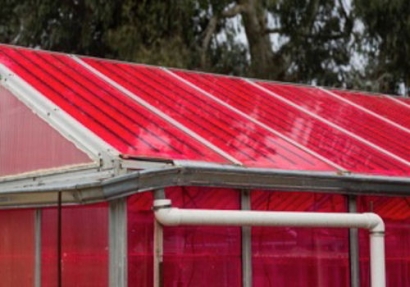
"We have demonstrated that 'smart greenhouses' can capture solar energy for electricity without reducing plant growth, which is pretty exciting," said Michael Loik, professor of environmental studies at the UC Santa Cruz and lead author on a paper that appears in the current issue of the American Geophysical Union's journal Earth's Future.
Electricity-generating solar greenhouses utilize Wavelength-Selective Photovoltaic Systems (WSPVs), a novel technology that generates electricity more efficiently and at less cost than traditional photovoltaic systems.
The greenhouses are outfitted with bright magenta transparent roof panels that absorb light and transfer energy to photovoltaic strips, where electricity is produced. WSPVs absorb some of the blue and green wavelengths of light but let the rest through, allowing the plants to grow.
The technology was developed by coauthors Sue Carter and Glenn Alers, both professors of physics at UC Santa Cruz, who founded Soliculture in 2012 to bring the technology to market.
Reducing the energy consumed by greenhouses has become a priority as the global use of greenhouses for food production has increased six-fold over the past 20 years to more than 9 million acres today—roughly twice the size of New Jersey, according to Loik. "It's big and getting bigger," he said. "Canada relies heavily on greenhouses for vegetable production, and their use is growing in China, too."
Plastic greenhouses are becoming popular for small-scale commercial farming, as well as for household food production, he added.
Greenhouses use electricity to control temperature and power fans, lights, and other monitoring systems. "This technology has the potential to take greenhouses offline," said Loik, who specializes in climate change, plant physiology, water resources, and sustainable technologies. Cost per panel of WSPV technology is 65 cents per watt—about 40 percent less than the per-watt cost of traditional silicon-based photovoltaic cells.
"If greenhouses generate electricity on site, that reduces the need for an outside source, which helps lower greenhouse gas emissions even more," said Loik. "We're moving toward self-sustaining greenhouses."
Additional coauthors include Catherine Wade, who participated as a graduate student, Carley Corrado, who participated as a postdoctoral researcher, and undergraduates David Shugar and Devin Jokerst, all of UC Santa Cruz; and Carol Kitayama, senior grower at Kitayama Brothers Growers.
Photo: Plants grown in this "smart" greenhouse fared as well or better than plants grown in conventional greenhouses. (Photo by Nick Gonzales)
.

